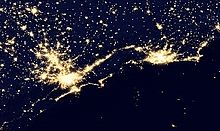Megalopolis
This article possibly contains original research. (March 2018) |
| Ekistics |
|---|
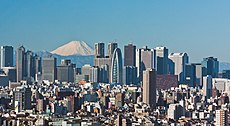 |
|
A megalopolis (/ˌmɛɡəˈlɒpəlɪs/), sometimes called a megapolis; also megaregion, city cluster or supercity,[1] is a group of two or more roughly adjacent metropolitan areas, which may be somewhat separated or may merge into a continuous urban region. The megalopolis concept has become highly influential as it introduced a new, larger scale in thinking about urban patterns and urban growth.[2]
Etymology[]
The term was coined by Patrick Geddes in his 1915 book Cities in Evolution,[3][4] and used by Oswald Spengler in his 1918 book The Decline of the West, and Lewis Mumford in his 1938 book The Culture of Cities, which described it as the first stage in urban overdevelopment and social decline. Later, it was used by Jean Gottmann in his landmark 1961 study, Megalopolis: The Urbanized Northeastern Seaboard of the United States, to describe what is now commonly known as the Northeast megalopolis a.k.a. BosWash.[5][6][7] The term has been interpreted as meaning "supercity".[1] In 1994 the magazine National Geographic (Vol 186, No.1 July 1994) featured a "Double Map Supplement: Megalopolis" of Boston to Washington Circa 1830 and on the flip-side a contemporary (1994) map of the same region to coincide with the 33 page feature article "Breaking New Ground: Boston" by William S. Ellis Photographs Joel Sartore. The contemporary 1994 map cites the term Megalopolis being first used in 1961 to refer to the BosWash region.
Definitions[]
This section needs additional citations for verification. (September 2021) |

Megalopolis is often spelled Megapolis. Both are derived from μέγας (mégas) in Ancient Greek meaning 'great' and πόλις (pólis) meaning 'city', therefore literally a 'great city' (compare "megacity"). Because in Greek, πόλις is feminine, the etymologically correct term is megalopolis. Literally, megalopolis in Greek means a city of exaggerated size where the prefix megalo- represents a quantity of exaggerated size.[8] The Ancient Greek city of Megalopolis was formed by the Arcadian League by bringing together smaller communities.
A megalopolis, also known as a megaregion, is a clustered network of cities. Gottmann defined its population as 25 million.[9] Doxiadis defined a small megalopolis a similar cluster with a population of about 10 million.[10][11][12] America 2050,[13] a program of the Regional Plan Association, lists 11 megaregions in the United States and Canada.[10] Megaregions of the United States were explored in a July 2005 report by Robert E. Lang and Dawn Dhavale of the Metropolitan Institute at Virginia Tech.[14] A later 2007 article by Lang and Nelson uses 20 megapolitan areas grouped into 10 megaregions.[15] The concept is based on the original Megalopolis model.[12]
Modern interlinked ground transportation corridors, such as rail and highway, often aid in the development of megalopolises. Using these commuter passageways to travel throughout the megalopolis is informally called megaloping. This term was coined by Davide Gadren and Stefan Berteau.[16]
In Brazil, the term megarregião has a legal meaning, different from the English word megaregion: Mesoregions of Brazil (mesorregião) and Microregions of Brazil (microrregião).
In China, the official term corresponding to the meaning of "megalopolis" is 城市群 (chéngshì qún), which literally means "city cluster". In Standard for basic terminology of urban planning (GB/T 50280—98) issued in 1998, 城市群 is defined as "An area in which cities are relatively densely distributed in a certain region" but wrongly translated as "agglomeration". In addition, there used to be no clear distinction between "megalopolis" and "metropolitan area" (都市圈) in Chinese context until National Development and Reform Commission issued Guidelines on the Cultivation and Development of Modern Metropolitan Areas on 19 February 2019 and clarified the definition of a metropolitan area.
Africa[]
- Cairo–Giza–Qalyubia–Helwan–6th of October City (Greater Cairo), Egypt (16 million) The area around the Nile is also very densely populated.[citation needed]
- Nile River Delta Governorates (Alexandria, Beheira, Kafr el-Sheikh, Gharbia, Monufia, Qalyubia, Dakahlia, Damietta, Al Sharqia, and Port Said) have a combined population of 41,045,135. The total area of these Governorates is 18,199 square miles making the population density 2,255.4 per square mile.[citation needed]
- The Gauteng City Region (PWV) in South Africa, which includes the urbanised portion of Gauteng Province (Pretoria, Centurion, Midrand, Johannesburg and the Vaal Triangle, with a population of over 14 million)[17][18][19]
- The region in Morocco including El Jadida-Casablanca-Rabat-Salé-Kenitra, concentrating in the long coastal belt, on around 250 km with a depth of 40 to 50 km, more than 11 million inhabitants.[citation needed]
- The Nairobi Metropolitan Region consisting of the counties of (Kajiado-Kiambu-Nairobi-Machakos-Murang'a) in Kenya, which have a combined population of 8 million people.[20]
North America[]
This section needs additional citations for verification. (September 2021) |
Transnational[]
| Megalopolis name | Population in millions 2011 |
Population in millions 2025 (projected) |
Population percent growth 2011 - 2025 (projected) |
Major cities |
|---|---|---|---|---|
| Cascadia | 8.4 | 8.8 | 5.0% |
|
| Great Lakes | 55.5 | 60.7 | 9.4% |
|
| Southern California | 24.4 | 29 | 18.9% |
|
Canada[]
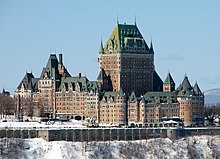

| Megalopolis name | Population in millions 2011 |
Population in millions 2025 (projected) |
Population percent growth 2011 - 2025 (projected) |
Major cities | Related articles |
|---|---|---|---|---|---|
| Quebec City–Windsor Corridor | 18.4 | 21 | 14.1% | Hamilton, Kingston, Kitchener, London, Mississauga, Montreal, Oshawa, Ottawa, Peterborough, Quebec City, Toronto, Trois-Rivières, Vaughan, Windsor | Southern Ontario, Quebec |
| Golden Horseshoe | 10.0 | 11.0 | 10% | Durham Region, Halton Region, Hamilton, Niagara Region, Peel Region, Toronto, York Region | Great Lakes, Southern Ontario |
| Calgary–Edmonton Corridor | 2.7 | 4 | 48.1% | Calgary, Edmonton, Red Deer, St. Albert, Airdrie | Calgary Region, Edmonton Capital Region, Central Alberta |
Mexico[]
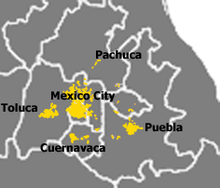
| Megalopolis name | Population in millions |
Major cities | Related articles |
|---|---|---|---|
| Mexico City megalopolis | 30.8 | Mexico City, Puebla, Cuernavaca, Toluca, Pachuca, Tula, Tlaxcala, Cuautla, Tulancingo | Mexico City megalopolis |
| Bajío | 11 | León, Querétaro, Aguascalientes, Celaya, Irapuato, San Juan del Río, Salamanca | Bajío |
| Monterrey-Saltillo-Monclova megalopolis | 5.3 | Monterrey, Saltillo, Monclova | |
| Guadalajara-Puerto Vallarta-Ocotlán megalopolis | 5 | Guadalajara, Puerto Vallarta, Ocotlán | |
| Veracruz-Xalapa-Córdoba megalopolis | 1.8 | Veracruz, Xalapa, Córdoba | |
| San Luis Potosí-Rioverde-Ciudad Fernández megalopolis | 1.2 | San Luis Potosí, Rioverde, Ciudad Fernández | |
| Matamoros-Nuevo Laredo megalopolis | 0.87 | Matamoros, Nuevo Laredo | |
| Acayucan-Coatzacoalcos-Minatitlán megalopolis | 0.81 | Acayucan, Coatzacoalcos, Minatitlán |
Note: Tijuana, Mexico is part of the Southern California megalopolis.
United States[]

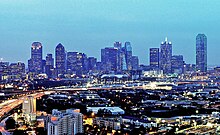


Constituent urban areas of each megalopolis are based on reckoning by a single American organization, the Regional Plan Association (RPA). The RPA definition of the Great Lakes Megalopolis includes some Canadian metropolitan areas with the United States including some but not all major urban centres in the Windsor-Quebec City Corridor. Note that one city, Houston, is listed in two different Megalopolis regions as defined by the RPA, (the Gulf Coast and Texas Triangle).77% of the US population live in at least one of the megalopolis listed below.[10][21]
| Megalopolis name | Population in millions 2010 |
Percent of U.S. Population (2010) | Population in millions 2025 (projected) |
Population percent growth 2010 - 2025 (projected) |
Major cities |
|---|---|---|---|---|---|
| Arizona Sun Corridor[22][23] | 5.6 | 2% | 7.8 | 39.3% | Mesa, Phoenix, Tucson, Prescott, Scottsdale |
| Northern California | 14 | 5% | 16.4 | 17.1% | Fresno, Modesto, Oakland, San Francisco, San Jose, Stockton, Berkeley, Cupertino, Fremont, Reno, Sacramento, Santa Rosa |
| Southern California | 24.4 | 8% | 29 | 18.9% | Los Angeles, San Diego, Santa Barbara, San Bernardino, Riverside, Bakersfield, Las Vegas, Long Beach, Tijuana |
| Cascadia | 12.4 | 3% | 13.5 | 8.2% | Abbotsford, Boise, Eugene, Portland (OR), Salem, Seattle, Tacoma, Spokane, Tri-Cities, Vancouver (BC), Vancouver (WA), Victoria |
| Florida | 17.3 | 6% | 21.5 | 24.3% | Jacksonville, Fort Lauderdale, Miami, Tampa, St. Petersburg, Sarasota, Fort Myers, Orlando, Gainesville, Palm Bay, Pensacola |
| Front Range | 5.5 | 2% | 6.9 | 26% | Albuquerque, Cheyenne, Colorado Springs, Denver, Pueblo, Salt Lake City, Santa Fe |
| Great Lakes | 59.1 | 18% | 65.7 | 10% | Buffalo, Chicago, Cincinnati, Cleveland, Columbus, Detroit, Hamilton, Indianapolis, Kansas City, Louisville, Milwaukee, Minneapolis, Montreal, Ottawa, Quebec City, Pittsburgh, Rochester, St. Louis, Toronto |
| Gulf Coast | 13.4 | 4% | 16.3 | 21.6% | Baton Rouge, Corpus Christi, Houston, McAllen, Brownsville, Mobile, Gulfport, Biloxi, New Orleans, Pensacola |
| Northeast | 52.3 | 17% | 58.4 | 11.7% | Allentown-Bethlehem, Atlantic City, Baltimore, Boston, Edison, Hagerstown, Harrisburg, Hazleton, Knowledge Corridor (Springfield and Hartford), Manchester (NH), Nashua, New Haven, New York, Newark, Norfolk, Ocean City, Philadelphia, Portland (ME), Pottsville, Providence, Reading, Richmond, Scranton/Wilkes-Barre, Trenton, Virginia Beach, Washington, Waterbury, Wilmington, Worcester |
| Piedmont Atlantic | 17.6 | 6% | 21.7 | 23.3% | Atlanta, Charlotte, Research Triangle, Raleigh, Durham, Chapel Hill, Greensboro, Winston-Salem, Greenville, Huntsville, Nashville, Chattanooga, Knoxville, Memphis, Birmingham, Montgomery, Clarksville, Murfreesboro, Tuscaloosa |
| Texas Triangle | 19.7 | 6% | 24.8 | 25.9% | Austin, Dallas, Fort Worth, Houston, San Antonio |
South America[]
This section needs additional citations for verification. (September 2021) |
Argentina[]

| Megalopolis Name | Population in 2013 |
Major cities | Other cities |
|---|---|---|---|
| 13,641,973 | Buenos Aires; Merlo, Moreno; Quilmes; Florencio Varela, La Matanza | Lanús; Lomas de Zamora, San Martin;Avellaneda;Zárate;San Pedro;San Nicolás de los Arroyos; and Rosario |
Brazil[]
| Megalopolis Name | Population in 2015[24] |
Major cities | Other cities |
|---|---|---|---|
| Rio de Janeiro–São Paulo Megalopolis | +51,500,000 | São Paulo Macrometropolis and Greater Rio de Janeiro | Santos, Campinas, São José dos Campos, Sorocaba, Jundiaí, Piracicaba, Mogi Guaçu, Bragança Paulista, Volta Redonda, Barra Mansa, Pouso Alegre, Varginha and Juiz de Fora |
| São Paulo Macrometropolis | +34,500,000 | São Paulo, Campinas, São José dos Campos, Sorocaba, Jundiaí, Piracicaba, Santos | Guarulhos, Osasco, ABC Region, Mogi das Cruzes, Americana, Limeira, Rio Claro, Bragança Paulista, Itu, Itapetininga São Vicente, Guarujá, Taubaté and Pindamonhangaba |
| Greater Rio de Janeiro | +13,000,000 | Rio de Janeiro and São Gonçalo | Nova Iguaçu, Duque de Caxias, Niterói, Belford Roxo and São João de Meriti |
| Greater Belo Horizonte | +5,800,000 | Belo Horizonte and Contagem | Betim, Nova Lima and Sete Lagoas |
| Greater Porto Alegre | +4,200,000 | Porto Alegre and Canoas | São Leopoldo, Novo Hamburgo and Gravataí |
| Recife metropolitan area | +3,900,000 | Recife and Jaboatão dos Guararapes | Olinda, Paulista, Cabo de Santo Agostinho, Camaragibe, Igarassu, São Lourenço da Mata, Abreu e Lima, Ipojuca, Moreno, Itapissuma, Ilha de Itamaracá, Araçoiaba and Goiana |
| +3,900,000 | Salvador and Camaçari | São Francisco do Conde, Lauro de Freitas, Simões Filho, Candeias, Dias d'Ávila, Mata de São João, Pojuca, São Sebastião do Passé, Vera Cruz, Madre de Deus and Itaparica | |
| Greater Curitiba | + 3,500,000 | Curitiba and São José dos Pinhais | Araucária, Colombo, Fazenda Rio Grande, Lapa and Pinhais |
Colombia[]
The following megaregions in Colombia are expected to have nearly 93% (55 Million people) of its population by 2030, up from the current 72%[citation needed]. There are currently 4 major megaregions in Colombia.
| Megalopolis name | Population in 2015 | Population in 2030 (projected) | Major cities |
|---|---|---|---|
| Bogota National Capital Metropolis | 17,000,000 | 26,500,000 | Bogotá, Soacha, Facatativá, Chía, Tunja, Fusagasugá, Zipaquirá, Madrid, Funza, Cajicá, Ubaté, Sibaté, Guaduas, Villa de Leyva and Tocancipá |
| Pacific Belt | 9,000,000 | 14,000,000 | Medellín, Cali, Bello, Pereira, Manizales, Armenia, Itagüí, Yumbo, and Palmira |
| Northeast Atlantic Region | 6,000,000 | 10,500,000 | Barranquilla, Cartagena, Santa Marta, Ciénaga, Malambo, Baranoa and Turbaco |
| Santander Belt | 3,000,000 | 5,200,000 | Bucaramanga, Cúcuta, Ocaña, and Pamplona |
Other sources[25] show that another megaregion may be considered:
| Megalopolis name | Population in 2015 | Population in 2030 (projected) | Major cities |
|---|---|---|---|
| Golden Triangle | 29,500,000 | 41,000,000 | Bogotá, Soacha, Medellín, Cali, Bello, Manizales, Armenia |
Peru[]
| Megalopolis name | Population in 2013 |
Major cities | Other cities |
|---|---|---|---|
| Lima-Callao Megalopolis | 10,523,796 | Lima and Callao | – |
Venezuela[]
| Megalopolis name | Population in 2013 |
Major cities | Other cities |
|---|---|---|---|
| Caracas-Valencia Megalopolis | +9,000,000 | Caracas, Valencia, and Maracay | Cagua, Maiquetía, and Guatire |
East Asia[]
This section needs additional citations for verification. (September 2021) |
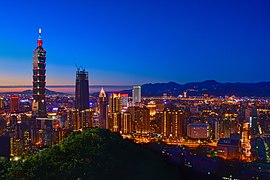
Taipei, Taiwan
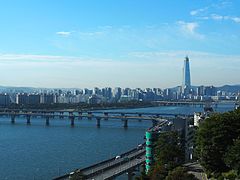
Seoul, South Korea

Hong Kong

Taichung, Taiwan
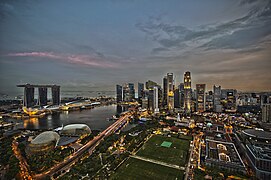
Singapore

Shanghai, China
China[]

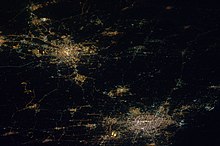
- Pearl River Delta Megalopolis (珠江三角洲) a.k.a. Guangdong-Hong Kong-Macau Greater Bay Area (粤港澳大湾区): Hong Kong, Shenzhen, Dongguan, Guangzhou, Foshan, Jiangmen, Zhongshan, Zhuhai, Macau, Huizhou (55,000,000).[26][27] Pan-Pearl River Delta further includes provinces adjacent to Guangdong.
- Yangtze River Delta Megalopolis (长江三角洲): Shanghai, Nanjing, Hangzhou, Ningbo, Suzhou, Jingjiang, Wuxi, Changzhou, Zhenjiang, Yangzhou, Taizhou, Nantong, Huzhou, Jiaxing, Shaoxing, Jiangyin, Haimen, Zhangjiagang, Zhoushan, Ma'anshan (88,000,000)[28]
- Bohai Economic Rim (环渤海经济圈): Beijing, Shenyang, Tianjin, Dalian, Anshan, Fushun, Dandong, Sinuiju, Tangshan, Yantai, Jinan, Qinhuangdao, Qingdao, Weihai (66,400,000)[29]
- Western Taiwan Straits Economic Zone (海峡西岸经济区): Xiamen, Fuzhou, Wenzhou, Shantou, Jieyang, Chaozhou (25,000,000)
- Central Plain (中原): Kaifeng, Xinxiang, Zhengzhou, Luoyang (14,170,000)
- Central-Southern Liaoning (辽中南): Within 150 km from its center Shenyang (7.2 million), it has Fushun (3 million), Anshan City (3.6 million), Benxi (1.5 million), Liaoyang (1.8 million), Yingkou (2.2 million), Panjin (1.2 million), and Tieling (3.4 million), with a total population of 23 million. And it can be further extended to Dalian (6.2 million), Fuxin (2 million) and Dandong (2.4 million). This area used to be the most industrialized region in China but began to decline in the 1980s.
- Harbin-Changchun Megalopolis (哈长城市群) a.k.a. Northeastern Cities (东北城市群): Harbin, Qiqihar, Daqing, Changchun, Jilin City, Siping including Rason in North Korea and Vladivostok in Russia (21,832,000)
- Sichuan basin (四川盆地) a.k.a. Chengyu Megalopolis (成渝都市圈): Chengdu, Chongqing, Mianyang, Deyang, Leshan, Meishan, Ziyang, Zigong, Luzhou
- Greater Wuhan Megalopolis (大武汉都市圈): Wuhan, Huangshi, Xinyang, Jiujiang, Yueyang (20,000,000)
- Guanzhong (关中): Xi'an, Xianyang, Baoji, Weinan (16,722,000)
- Changzhutan Megalopolis (长株潭城市群) a.k.a. Greater Changsha Metropolitan Region (大长沙都市圈): Changsha, Zhuzhou, Xiangtan (12,994,400 in 2000)
In July 2012, the Economist Intelligence Unit brought out a report entitled; Supersized cities: China's 13 megalopolises, which pinpoints the 13 emerging megalopolises in China, and highlights the demographic and income trends that are shaping their development.
Japan[]
Japan is made up of overlapping megapolises. The Taiheiyō Belt megapolis itself includes both the Greater Tokyo Area and Keihanshin megapoles.
- Taiheiyō Belt – Ibaraki, Saitama, Chiba, Tokyo, Kanagawa, Shizuoka, Aichi, Gifu, Mie, Kyoto, Osaka, Hyōgo, Wakayama, Okayama, Hiroshima, Yamaguchi, Fukuoka, and Ōita in Japan. (81,859,345)[30][31][citation needed]
- Greater Tokyo Area - Part of the larger Kantō region, broadly including Tokyo and Yokohama, Japan's two most populous cities. (38,000,000)[32]
- Keihanshin - Part of the larger Kansai region, includes Osaka, Kyoto, Kobe. (19,341,976)[33]
South Korea[]
- Seoul National Capital Area - Seoul, Incheon, Suwon, Goyang, Yongin, Seongnam, and the rest of Gyeonggi-do: (25,000,000)[34]
Taiwan[]

- West Coast of the island of Taiwan - Taipei, New Taipei, Keelung, Taoyuan, Hsinchu, Taichung, Chiayi, Tainan, and Kaohsiung: (18,000,000)
South Asia[]

India[]
- Kolkata Megalopolis[35] - Some areas of Presidency, Medinipur and burdwan divisions. Population 65 million.
- Delhi Megalopolis[36] - National Capital Region (India). Population 46 million.
- Chennai Megalopolis[37] - Chennai Metropolitan Region, Kanchipuram, Tiruvallur, Chengalpattu and Vellore. Population 20 million.
- Mumbai Megalopolis[38] - Mumbai Megalopolis includes Mumbai Metropolitan Region, Pune Metropolitan Region and Nashik Metropolitan Region. This area is also known as golden Triangle of Maharashtra.[39][40] Population 80 million.
Southeast Asia[]
This section needs additional citations for verification. (September 2021) |

Jakarta, Indonesia

Manila, Philippines

Bangkok, Thailand

Ho Chi Minh City, Vietnam

Kuala Lumpur, Malaysia

Singapore

Hanoi, Vietnam

Surabaya, Indonesia
| Rank | Megalopolis name | Country | Population in millions |
Major cities |
|---|---|---|---|---|
| 1 | Java | 145[41] | Jakarta, Serang, Tangerang, South Tangerang, Bekasi, Depok, Bogor, Sukabumi, Cimahi, Bandung, Tasikmalaya, Cirebon, Tegal, Pekalongan, Semarang, Surakarta, Yogyakarta, Madiun, Kediri, Mojokerto, Surabaya, Batu, Malang, Pasuruan, Probolinggo | |
| 2 | Mega Manila | 40+ | Manila, Calamba, Angeles City, Baguio, Batangas, Dagupan, Olongapo, Bacoor | |
| 3 | Southeast Economic Zone | 16+ | Đồng Nai, Bình Dương, Ho Chi Minh City, Bà Rịa–Vũng Tàu Province, Long An, Tiền Giang |
Indonesia[]
Java island (population 145,013,573) - At over 1,100 people per km2 in 2014, it is also one of the most densely populated parts of the world, on par with Bangladesh. Every region of the island has numerous volcanoes, leaving people to share the remaining flatter land. Because of this, many coasts are heavily populated and cities ring around the valleys surrounding volcanic peaks.
The population growth rate more than doubled in economically depressed Central Java in the latest 2010–2015 period vs 2000–2010, indicative of migration or other issues; there were significant volcanic eruptions during the earlier period. Approximately 45% of the population of Indonesia is ethnically Javanese, while Sundanese make a large portion of Java's population as well.
Jakarta metropolitan area is made up of several regencies and cities:
- Special Capital Region of Jakarta (all 44 districts) (10,135,030)
- City of Bekasi (all 12 districts) (2,381,053)
- City of Bogor (all 6 districts) (982,469)
- City of Depok (all 11 districts) (1,631,951)
- City of South Tangerang (all 7 districts) (1,219,245)
- City of Tangerang (all 13 districts) (1,566,190)
- Bekasi Regency (all 23 districts) (3,500,023)
- Bogor Regency (all 40 districts) (5,715,009)
- Cianjur Regency (only 4 districts[42])
- Tangerang Regency (all 29 districts) (3,802,999)
total area 7,062.47 km2 and population 33,430,285 in 2015[43]
Surabaya metropolitan area or Greater Surabaya
- City of Surabaya (all 31 districts) (2,847,480)
- City of Mojokerto (all 2 districts) (125,657)
- Bangkalan Regency (all 18 districts) (953,659)
- Gresik Regency (only 16 districts, excluding Bawean) (1,255,042)
- Lamongan Regency (all 27 districts) (1,187,742)
- Mojokerto Regency (all 18 districts) (1,079,499)
- Sidoarjo Regency (all 18 districts) (2,114,493)
total area 5,925.84 km2 and population 9,570,870 in 2015[44] and having population about 10,500,000 in 2020 estimates
Bandung metropolitan area or Greater Bandung
- City of Bandung (all 30 districts)
- City of Cimahi (all 3 districts)
- Bandung Regency (all 31 districts)
- Sumedang Regency (only 5 districts)
- West Bandung Regency (all 15 districts)
total area 3,411.35 km2 and population 8,357,393 in 2015[45] and having population about 10,000,000 in 2020 estimates
Philippines[]
Mega Manila area 50,525.48 km2 is made up of 4 Regions:
- Central Luzon (11,218,117)
- Metro Manila (12,877,253)
- Calabarzon (14,414,774)
- Mimaropa excluding Palawan (2,113,891)
(Regional Centers) San Fernando-Manila-Calamba-Calapan
Total Population of Mega Manila as of 2015: (40,624,035)[46]
Thailand, Malaysia, Singapore and Vietnam[]
- Bay of Bangkok Economic Rim: Bangkok–Ayutthaya–Pattaya (16,000,000)
- Sijori: Johor Bahru–Singapore–Batam–Bintan (10,000,000) [47][48][49]
- Red River Delta in Vietnam (Hanoi, Hai Phong, Nam Định, & Hải Dương) (10,000,000)[50][51]
West Asia[]
Iran[]
- Greater Tehran: A region located in Iranian Tehran and Alborz Province in central Northern Iran with its influence expanding in Qom Province, Qazvin Province and Mazandaran Province, home for at least 15 million people, it is one of the most populous urban areas in the Greater Middle East and the surrounding regions. Tehran was a small village 200 years ago when it was first chosen as the Capital city and it has been growing at a very fast rate.[citation needed]
Israel[]
- Gush Dan: Tel Aviv-Jaffa and the surrounding municipalities, forming an urban area with population of approximately 4 million people.[citation needed]
Turkey[]
- : In addition to the mega cities of Istanbul and Bursa; Gebze, Yalova İzmit and Adapazarı cities form a contiguous urban area.[52][53] In 2020, these provinces are home to about 21 million people.[54]
 Istanbul, Kocaeli and Sakarya Provinces at Night
Istanbul, Kocaeli and Sakarya Provinces at Night
Europe[]

Transnational (Europe)[]
| Rank | Megalopolis Name | Population in millions | Countries & Respective Cities |
|---|---|---|---|
| 1 | Blue Banana | 110–130[55] | |
| 2 | Golden Banana | 40–45[56] | |
| 3 | STRING | 12.8[57] | |
| 4 | 40-45 | ||
| 5 | Atlantic Axis | 10[58][59] | |
| 6 | Gulf of Finland | 8 |
The Moscow megalopolis in Russia has approximately 40 million people and includes the region around Moscow.
Oceania[]
Australia[]
| Megalopolis Name | Population in millions |
Major cities |
|---|---|---|
| Greater Southeast Megalopolis[60] | 15.68[61] |
|
Fiction[]
Metropolis[]
Metropolis is a 1927 German expressionist science-fiction drama film directed by Fritz Lang. Written by Thea von Harbou in collaboration with Lang,[62][full citation needed][63][full citation needed] it stars Gustav Fröhlich, Alfred Abel, Rudolf Klein-Rogge and Brigitte Helm. Erich Pommer produced it in the Babelsberg Studios for Universum Film A.G. (Ufa). The silent film is regarded as a pioneering science-fiction movie, being among the first feature-length movies of that genre.[64] Filming took place over 17 months in 1925–26 at a cost of over five million Reichsmarks.[65]
Judge Dredd[]
In Judge Dredd (1977), Mega-City One is a huge fictional megalopolis-size city-state covering much of what is now the Eastern United States and some of Canada in the Judge Dredd comic book series and its spinoff series. The exact geography of the city depends on which writer and artist has done which story, but from its first appearance it has been associated with New York City's urban sprawl; originally it was presented as a future New York, which was retconned as the centre of a "Mega-City One" in the very next story.[66] The Architects' Journal placed it at No. 1 in their list of "comic book cities".[67]
Blade Runner[]
Blade Runner is a 1982 neo-noir science fiction film directed by Ridley Scott, written by Hampton Fancher and David Peoples, and starring Harrison Ford, Rutger Hauer, Sean Young, and Edward James Olmos. It is a loose adaptation of Philip K. Dick's novel Do Androids Dream of Electric Sheep? (1968). The film is set in a dystopian future Los Angeles of 2019, in which synthetic humans known as replicants are bio-engineered by the powerful Tyrell Corporation to work on off-world colonies. When a fugitive group of replicants led by Roy Batty (Hauer) escapes back to Earth, burnt-out cop Rick Deckard (Ford) reluctantly agrees to hunt them down.
Sprawl trilogy[]
In William Gibson's Sprawl trilogy, "the Sprawl" is a colloquial name for the "Boston-Atlanta Metropolitan Axis" (BAMA), an urban sprawl environment on a massive scale, and a fictional extension of the real Northeast megalopolis. The Sprawl is a visualization of a future where virtually the entire East Coast of the United States, from Boston to Atlanta, has melded into a single mass of urban sprawl.[68] It has been enclosed in several geodesic domes and merged into one megacity. The city has become a separate world with its own climate, no real night/day cycle, and an artificial sky that is always grey.
See also[]
|
|
References[]
- ^ Jump up to: a b Fielder, W.; Feeney, Georgiana (1976). Inquiring about Cities: Student text. Holt, Rinehart and Winston. pp. 193, 299. ISBN 9780030897849. Retrieved 2018-06-25.
- ^ Caves, R. W. (2004). Encyclopedia of the City. Routledge. p. 456. ISBN 9780415252256.
- ^ Geddes, Patrick (1915). Cities in Evolution. London: Williams & Norgate – via Internet Archive.
- ^ "MEGALOPOLIS". Environmental Cloud Atlas. Syracuse University School of Architecture.
Patrick Geddes coined this term in the early twentieth century that described the regional city's counter-action through the process of conurbation...
- ^ Gottmann, Jean (1954). L'Amerique. Paris: Hachette.
- ^ Gottmann, Jean (1957). "Megalopolis, or the urbanization of the Northeastern Seaboard". Economic Geography. 33 (3): 189–200. doi:10.2307/142307. JSTOR 142307.
- ^ Gottmann, Jean (1961). Megalopolis. The Urbanized Northeastern seaboard of the United States. New York: The Twentieth Century Fund.
- ^ "Definition of the prefix megalo-". The American Heritage® Dictionary of the English Language, Fourth Edition. Houghton Mifflin Company. 2000.
- ^ Gottmann, Jean (1989). Since Megalopolis. The Urban Writings of Jean Gottmann. Baltimore and London: The Johns Hopkins University Press. p. 163.
- ^ Jump up to: a b c Taylor, Matt. "Megaregions". America 2050. Archived from the original on 2017-05-16. Retrieved 2017-04-06.
- ^ "Who's Your City?: What Is a Megaregion?". 19 March 2008. Archived from the original on 12 June 2010. Retrieved 5 October 2014.
- ^ Jump up to: a b "Cities: Capital for the New Megalopolis". Time. 4 November 1966. Archived from the original on 27 August 2013. Retrieved 19 July 2010.
- ^ "About Us". America 2050. Archived from the original on 6 October 2014. Retrieved 5 October 2014.
- ^ "Beyond Megalopolis: Exploring America's New "Megapolitan" Geography" (PDF). July 2005. Archived from the original (PDF) on 2009-03-27.
- ^ "America 2040: The Rise of the Megapolitans" (PDF). January 2007. Archived (PDF) from the original on 24 July 2013. Retrieved 5 January 2014.
- ^ Tremble, Sam (30 May 2007). "Fumbling Toward Portland". Philadelphia City Paper. Archived from the original on 7 July 2009.
- ^ "Archived copy". Archived from the original on 2006-10-07. Retrieved 2007-01-01.CS1 maint: archived copy as title (link)
- ^ "Archived copy". Archived from the original on 2006-09-24. Retrieved 2007-01-01.CS1 maint: archived copy as title (link)
- ^ "Welcome to the official South African government online site! | South African Government". Info.gov.za. Archived from the original on 2012-05-14. Retrieved 2017-04-06.
- ^ "Cabinet Secretary names team to modernize Nairobi city transport :: Kenya - The Standard". Standardmedia.co.ke. 2015-02-23. Archived from the original on 2015-07-13. Retrieved 2017-04-06.
- ^ Regional Plan Association (2008). America 2050: An Infrastructure Vision for 21st Century America. New York: Regional Plan Association.
- ^ "Megapolitan: Arizona's Sun Corridor". Morrison Institute for Public Policy. May 2008. Archived from the original on 2008-06-15. Retrieved 2008-06-03.
- ^ Catherine Reagor (2006-04-09). "When Phoenix, Tucson Merge". The Arizona Republic. Retrieved 2016-05-31.
- ^ 46 - Instituto Brasileiro de Geografia e Estatística, Brazil, 2015, Brazilian Institute of Geography and Statistics, 28 August 2015, archived from the original on 19 December 2016, retrieved 28 August 2016
- ^ Ordóñez Burbano, Luis A. (2007). Universidad del Valle 60 años 1945-2005: Atando cabos en clave de memoria. Cali, Valle del Cauca, Colombia: Universidad del Valle. p. 58. OCLC 645219600
- ^ John Vidal. "UN report: World's biggest cities merging into 'mega-regions' | World news". The Guardian. Archived from the original on 2017-05-08. Retrieved 2017-04-06.
- ^ "关于长江三角洲构建世界第六大城市群的思考". Archived from the original on 23 September 2015. Retrieved 5 October 2014.
- ^ Vidal, John (2010-03-22). "UN report: World's biggest cities merging into 'mega-regions'". The Guardian. London. Archived from the original on 2016-09-10. Retrieved 2016-09-09.
- ^ "Foreign investment shows trend of "moving northward"". china-embassy.org. 2004-05-14. Archived from the original on 2011-06-11. Retrieved 2010-01-09.
- ^ "地域活性化戦略(案)資料" (PDF) (in Japanese). Ministry of Economy, Trade and Industry. p. 4. Archived (PDF) from the original on September 23, 2016. Retrieved August 13, 2016.
- ^ "2015 Population Census". Statistics Bureau, Ministry of Internal Affairs and Communications. Archived from the original on August 25, 2016. Retrieved August 13, 2016.
- ^ United Nations (March 12, 2017). "The World's Cities in 2016" (PDF). United Nations
- ^ Japan Statistics Bureau - "2010 Census", retrieved August 23, 2015
- ^ A government publication states that on 1 November 2010, the population of "Seoul Metropolitan Area" stood at 23,616 thousand, which is the sum of the figures given for Gyeonggi-do (11,270 thousand), Seoul (9,708 thousand) and Incheon (2,638 thousand), apparently including the periphery.
Source: "Preliminary Results of the 2010 Population and Housing Census" Archived 2012-01-31 at the Wayback Machine (PDF). Statistics Korea. 21 January 2011. Retrieved 23 July 2011. - ^ Issues in Global Environment—Climate and Climate Change: 2013 Edition. May 2013. ISBN 9781490109657.
- ^ Kumar, Ashok (2013), "Delhi: Growing Problems of a Growing Megalopolis", in Misra, R. P. (ed.), Urbanisation in South Asia, Foundation Books, pp. 109–141, doi:10.1017/9789382993087.005, ISBN 9789382993087, retrieved 2019-08-21
- ^ "Chennai to become a megapolis, State government gives approval". The New Indian Express. Retrieved 2021-05-10.
- ^ "Mumbai set to become next Megalopolis". The Times of India. 2001-09-03. Retrieved 2019-08-21.
- ^ Kumar, K. Ram (2011-04-26). "A megalopolis with unlimited potential". @businessline. Retrieved 2019-08-21.
- ^ "Golden Triangle zone a litmus test for parties in Maharashtra polls". The Economic Times. 2014-09-30. Retrieved 2019-08-21.
- ^ "Java - Google Arts & Culture". Google Cultural Institute. Retrieved 2018-02-07.
- ^ (Cugenang, Pacet, Sukaresmi and Cipanas districts)
- ^ "PU-net". perkotaan.bpiw.pu.go.id.
- ^ "PU-net". perkotaan.bpiw.pu.go.id.
- ^ "PU-net". perkotaan.bpiw.pu.go.id.
- ^ "Google". Archived from the original on 2017-04-06. Retrieved 2017-04-06.
- ^ "Population and Population Structure - Latest Data".
- ^ https://knoema.com/atlas/Malaysia/Johor/Population
- ^ "Batam · Population".
- ^ "广西北部湾经济区概况". Archived from the original on 6 October 2014. Retrieved 5 October 2014.
- ^ "Chinese Cities on Beibu Gulf Increase Cooperation". Archived from the original on 13 November 2013. Retrieved 5 October 2014.
- ^ "The Real Powerhouses That Drive the World's Economy". www.bloomberg.com. Retrieved 2021-08-21.
- ^ Adler, Patrick; Florida, Richard; Hartt, Maxwell (2020). "Mega Regions and Pandemics". Tijdschrift voor Economische en Sociale Geografie. 111 (3): 465–481. doi:10.1111/tesg.12449. ISSN 1467-9663. PMC 7361226. PMID 32834149.
- ^ "List of Cities in Turkey (Turkish)". www.nufusu.com. Retrieved 2021-08-21.
- ^ Ina Schmidt. "The European Blue Banana". Archived from the original on 6 October 2014. Retrieved 5 October 2014.
- ^ Pedrazzini, Luisa; Akiyama, Renata Satiko (2011). From Territorial Cohesion to the New Regionalized Europe. ISBN 9788838760341. Retrieved 5 October 2014.
- ^ "About | STRING". STRING. Retrieved 2020-05-24.
- ^ Lois-González, Rubén C. (7 October 2004). "A Model of Spanish-portuguese Urban Growth: the Atlantic Axis". Universidad de Santiago de Compostela. p. 7(287). Archived from the original on 8 December 2017. Retrieved 7 December 2017.
- ^ "EIXO ATLANTICO DO NOROESTE PENINSULAR".
- ^ http://soac.fbe.unsw.edu.au/2011/papers/SOAC2011_0030_final(1).pdf
- ^ 3218.0 - Regional Population Growth, Australia, 2014-15, Australian Bureau of Statistics, 30 March 2016, archived from the original on 5 October 2016, retrieved 3 October 2016
- ^ Magid 2006, p. 129.
- ^ Grant 2003, p. 14.
- ^ "Metropolis (1927)" Science Fiction Film History. Retrieved 15 May 2013. Quote: "Although the first science fiction film is generally agreed to be Georges Méliès' A Trip To The Moon (1902), Metropolis (1926) is the first feature length outing of the genre."
- ^ Hahn, Ronald M. and Jansen, Volker (1998) Die 100 besten Kultfilme [The 100 best cult movies] Munich: Heyne Filmbibliothek. p.396. ISBN 3-453-86073-X (German)
- ^ 2000 AD No. 2 and 3
- ^ Top 10 comic book cities: #1 Mega City One, Architects' Journal, July 8, 2009
- ^ Markoff, John (November 25, 1990). "Ideas & Trends; Art Invents A Jarring New World From Technology". The New York Times. Retrieved 2008-07-30.
- Magid, Annette M. (Summer 2006). "Better than the Book: Fritz Lang's Interpretation of Thea von Harbou's Metropolis" (PDF). Spaces of Utopia. No. 2. Universidade do Porto. pp. 129–149. ISSN 1646-4729. Retrieved 2021-04-06.
- Grant, Barry Keith, ed. (2003). Fritz Lang: Interviews. Conversations with Filmmakers Series. Jackson, Mississippi: University Press of Mississippi. ISBN 9781578065776.
External links[]
| Look up megalopolis in Wiktionary, the free dictionary. |
- Human habitats
- Urban studies and planning terminology
- City
